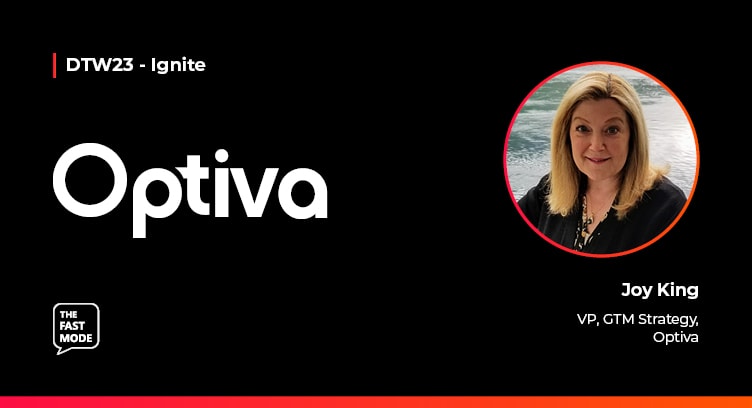As DTW23 - Ignite enters its second day, Ariana Lynn, Principal Analyst at The Fast Mode spoke to Joy King, VP of GTM Strategy at Optiva. Joy explores her predictions for the next year, the convergence of telco and cloud and her thoughts on generative AI.
Ariana: What are some emerging trends and technologies that you expect will power digital transformation in the telco space in the next year?
Joy: One of the most exciting business trends that we see is the pivot from the historical focus on connectivity, network capacity and underlying infrastructure to a focus on a contemporary digital customer experience. It means a fundamental shift in technology, especially for customer and partner onboarding, billing and charging. It means customized services, rapid time to market to capitalize on new opportunities immediately and most importantly, meeting the intuitive digital experience that all of us (personally and professionally) expect when we engage with any vendor for any product or service. To achieve this, a data-driven, ML-trained, AI insight BSS platform is necessary. It must be architected to embrace multiple data sources with an open architecture and industry-recognized APIs, like TM Forum OpenAPIs and ODA.
The restrictions of legacy BSS platforms require telecom operators to consider two paths to the future. Do they want to provide commodity infrastructure for MVNOs and new market entrants who bundle mobile network services with their offerings? Or do they want to create new digital brands with compelling and targeted services for specific applications and user demographics? Those operators who choose the commodity path will continue to focus on operational efficiency, cost reduction and maintenance. For companies who embrace the next generation of opportunity in the telecom market, investing in contemporary digital billing and charging software inspired by innovative hyperscaler architecture and powered by AI and automation will enable new revenue streams and a reimagined customer experience.
Ariana: How has the convergence of telco and cloud changed CSP monetization strategies? What are some new growth opportunities?
Joy: The telecom industry was the foundational definition of scale. No other industry handled the scope, regulation and capital investment at the scale of the telecom industry. As a result, custom bespoke solutions were crafted by a small number of specialty vendors that assumed full control of OSS, BSS and all other telecom infrastructure, ensuring life-long customer revenue streams with minimal competition.
Then came the public cloud providers, who elevated the definition of scale to an entirely new level. However, their approach to achieving and maintaining that scale fundamentally differed from the telecom industry. Instead of custom-built, services-led, individually crafted software, the “hyperscalers” built software designed for a digital world with an open architecture and focus on integration. The hyperscalers prioritized speed, agility and the ability to evolve and change constantly.
Today, hyperscalers represent both an opportunity and a challenge to the telecom industry. The opportunity is best represented by the telecom industry learning from the hyperscalers — focusing on personalized and customized offerings for different customer communities, both consumer and enterprise. The challenge is fear. What would happen if a telco committed to only a single cloud provider? Wouldn’t that be a repeat of the past restrictions that legacy OSS/BSS vendors imposed? The answer is yes. However, embracing a cloud-native architecture for new projects that delivers the benefits of cloud innovation but maintains the multi-cloud/public/private cloud options is the path forward.
Imagine a world, powered by 5G+ and AI, that enables remote medical services to rural communities. Imagine a world where farmers could receive real-time guidance for optimized crop production. Imagine a world where online gaming could be extended to meaningful education for students who struggle with traditional learning. The telecom industry can play a key role here.
Ariana: What are your thoughts on artificial intelligence (AI), specifically generative AI? Where is it heading?
Joy: Artificial intelligence, especially generative AI that can not only analyze, interpret and correlate data but also generate text, images and other forms of media, will have a big impact on all industries. Much like previous revolutions, it will change how we live and work. It will open new opportunities for businesses that see generative AI as “collaborative intelligence” rather than a replacement for human intelligence. The most successful use of AI will be where AI contributes the information that humans need to move quickly and efficiently and have the time and bandwidth to spend more time innovating and less time on high-volume, time-consuming tasks.
Creating customized services, including enterprise private networks and high-value consumer services powered by AI, represents a real opportunity for the telecom industry. Rather than think only about how generative AI might replace some jobs and reduce costs, which is typical commodity business thinking, telecom innovators should be thinking about how they can create platforms and services that can support the usage of AI, exactly as hyperscalers are doing, but with the advantage of 5G+ and other network specific technologies that are just as fundamental to AI as high compute and massive storage.




















